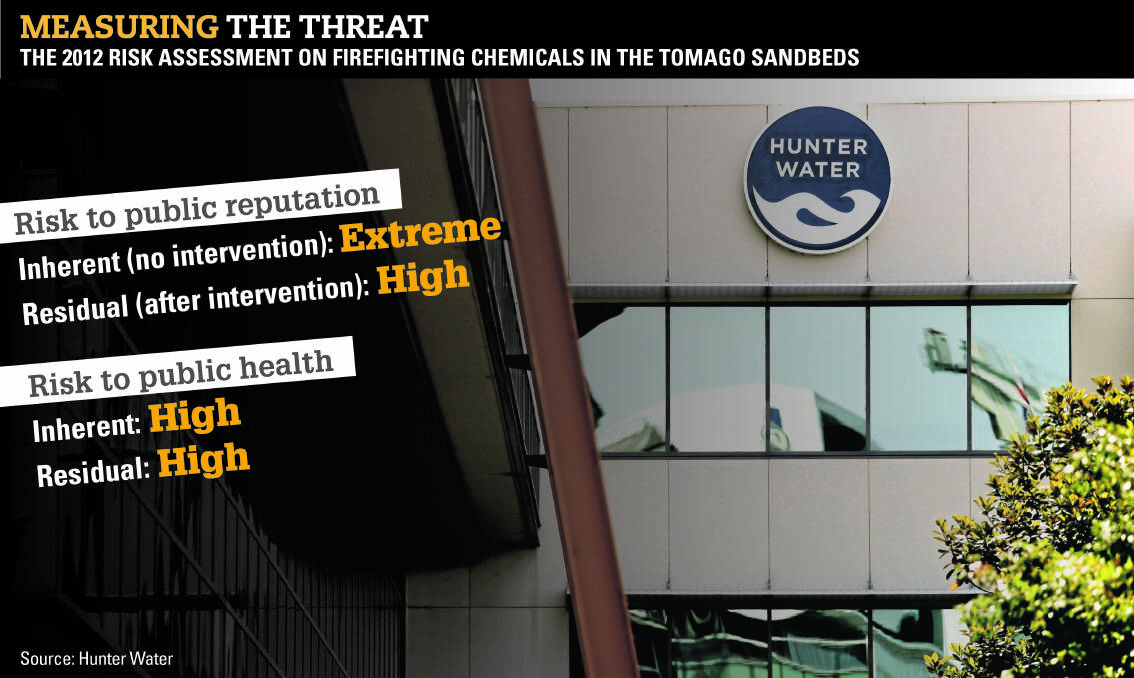
Potential contamination of the city’s drinking water supply by firefighting chemicals posed a “high risk” to public health and Hunter Water’s reputation – even with intervention to address the problem – a confidential report warned in July, 2012.
Subscribe now for unlimited access.
$0/
(min cost $0)
or signup to continue reading
The chemicals are known to be highly soluble, are difficult to remove, have long half-lives and are carcinogenic to humans."
- -2012 Hunter Water risk assessment
The risk assessment on the Tomago Sandbeds, which supply up to 20 per cent of Newcastle’s drinking water, has been obtained by the Newcastle Herald under freedom of information legislation.
It raised “significant” concerns about per- and poly-fluoroalkyl chemicals (PFAS) in the drinking water catchment, and was written two months after Defence alerted Hunter Water to the risk from decades of use of toxic firefighting foam on the Williamtown RAAF base.
Read more: Government moves toward $39 million PFOS ban
“The chemicals are known to be highly soluble, are difficult to remove, have long half-lives and are carcinogenic to humans,” the risk assessment stated.
Hunter Water backed away from the term carcinogenic when contacted for comment, saying it did not have a “detailed understanding” of the chemicals at the time it prepared the report.
“Hunter Water defers to the relevant health authorities for advice on risks associated with PFAS chemicals and does not endorse the choice of words in the 2012 risk report,” a spokesperson said.
The spokesperson defended Hunter Water’s decision not to inform the public of the findings in 2012, stressing that at the same time, it had sampled all pumping stations in the Tomago Sandbeds and had not had a single detect.
A later decision to embargo “at risk” bores meant there were no adverse impacts to the health of customers, he said.
“At the time the assessment was undertaken, and as is currently the case, drinking water supplied by Hunter Water is safe for consumption,” he said.
“This is confirmed by routine monitoring for PFAS at all water treatment plants and at 65 sampling locations across Hunter Water’s drinking water network.”
The risk assessment, prepared by a team of Hunter Water staff, examined the dangers posed by a number of contaminants in the catchment, including aluminium, arsenic, manganese, iron, heavy metals, fire retardants (PFAS), hydrocarbons, radiology, bacteria, viruses and parasites.
For each contaminant, the risk to “public reputation” and “public health” was classified as insignificant, low, medium, high or extreme.
The report dealt with the inherent risk, which generally represents a worst case scenario with no controls in place, and residual risk, the level of danger after controls are implemented.
PFAS posed the greatest threat to the catchment, with a high risk – both inherent and residual – to public health.
The inherent risk to public reputation was extreme, with a high residual risk.
“Previous firefighting training activities on RAAF land is the cause of the highest level of risk within the Tomago Catchment; however fire retardants may have been used elsewhere within the catchment by the Rural Fire Service,” the report said.
It recommended that Hunter Water seek information on where the chemicals may have been used within the catchment, introduce routine monitoring for the chemicals in raw and treated water, develop a memorandum of understanding with the Rural Fire Service and liaise with the RAAF base over the problem.
It was also recommended bores adjacent to RAAF land were not operated until modelling of the contamination flow was available and that “at risk” bores were not run simultaneously.
Manganese and hydrocarbons both posed a medium risk to public reputation, while all other contaminants were classed as low risk.
A review, which took place in late 2013, saw the residual PFAS risks downgraded to medium for both reputation and long term health effects on customers.
The review recommended Hunter Water contribute to the design of a RAAF plan to limit the risk of contamination to pumping station 7, and “consider the need to abandon” it altogether.
A formal embargo was placed on pumping stations 7 and 9 the following year. A third pumping station, number 5, was isolated after it was included in the Environment Protection Authority’s maps of the red zone.
“This embargo will not be lifted until a safe resolution can be met,” the Hunter Water spokesperson said.
The main pumping station of concern is number nine, to the east of the RAAF base. The chemical perfluoroctane sulfonate (PFOS) was detected in it at .03 micrograms per litre in 2009 and then at .17 micrograms per litre in 2015.
The second reading was more than double Australia’s safe limit for drinking water (.07 micrograms per litre), however the station has not been used for water supply since 2009 because of “favourable weather conditions and high dam storage levels”.
Pumping station 7, immediately north of the runway, has not had a positive detect. However Defence has found high levels of contamination in “proximity” to it.
“[The pumping station] presented a risk due to this close proximity to RAAF infrastructure and the potential for extended operation ... to affect groundwater gradients in its immediate proximity,” the spokesperson said.
Since 2012, there have been a number of trace detects at other bores within the sandbeds, but all below health guideline levels.
“[There is] therefore no additional health risk to Hunter Water customers beyond that expected in all drinking water supplies.”

